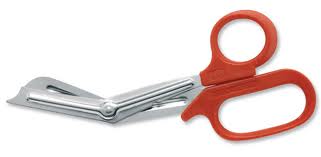Rescue Knife or "Tuff Cut" Shears?
Rescue knives are great; they feel purposeful and you can wear them like a badge of honour. For some it will be stealth black kept safe on their utility belt while for others it will be Hi-Viz yellow hanging from their climbing harness or strapped to their buoyancy aid. If a parcel needs opening or a pencil sharpening and there is a rescue knife available the owners will delight in the opportunity to open it up (with one hand) and pass it like a sacred totem to the lucky recipient.
But when was the last time you used one in a real emergency? Thankfully, unless rescue is part of your job, most of us rarely find the need to use a Rescue Knife in emergency situation. The Rescue Knife has been a part of an Outdoor Instructors kit since instructing in the outdoors became a legitimate business many years ago. Is it time we re-thought its place in our rucksack?
Rescue Knives
A rescue knife is purposeful, reflected in its design and if you choose to carry one there are several considerations that need to be made when choosing a Rescue Knife.
Fixed or Folding?
Fixed blade knives are the strongest. A 'full tang' knife where the metal of the blade continues down the full length of the handle is ideal for a heavy duty work knife. These knives are larger and therefore probably not appropriate to hanging from a climbing harness or strapped to a buoyancy aid.
A folding knife would be more appropriate being more compact and able to be stowed away more discretely. A dedicated rescue knife should be able to be opened single handedly and locked into an open position to prevent it inadvertently closing onto the users fingers. It is illegal to carry a locking knife in the UK in public so discretion should be used.
Sharp or blunt?
As a rule look for a blunt nosed knife. A sharp point only has use in piercing materials but the obvious danger is piercing yourself or the casualty. The exception to this might be a raft guide who may need a sharp point to pierce the raft to escape when capsized and / or pinned.
Straight edge or serrated?
A generic knife is typically straight edged, being easy to sharpen. As we tend not to use a rescue knife particularly frequently there should be little need to re-sharpen it. Serrated edges are much better at cutting rope but almost impossible to sharpen yourself without special tools.
Material?
A good quality knife will be made of either stainless steel or carbon steel. Stainless steel is much less prone to rust but less hard wearing and is difficult to sharpen. Carbon steel, however, requires more maintenance (regular cleaning and oiling, especially exposed to salty environments) but is cheaper than stainless steel. Many manufacturers tout their products as 'rust proof' as their products are stainless or carbon steel but a cost cutting measure is to use brass or mild steel washers at the pivot of the blade. While your blade may never rust, after a couple of dips in the sea it may never open.
Recommendations
One of the most popular rescue knives on the market is the Geber EZ-Out Rescue. A blunt nosed, single handed opening, fully serrated knife for around £30-£35. If you work on or around the sea then you need the most rust resistant knife you can afford. If your budget can manage it you won't go wrong with the Spyderco Salt Atlantic. Guaranteed not to rust yet able to retain a very sharp edge, but tipping the scales at around £70.
The alternatives - "Tuff Cut" shears
"Tuff Cuts" (also known as EMT Shears) are basic, simple, heavy duty scissors. Paramedics and other healthcare professionals have been using these for years. They can cut through most materials including ropes (both loose and under tension), wetsuits, webbing straps and even motorbike leathers but pose very little risk to the user or the casualty.
Think about it: you are trapped in a kayak, entangled in climbing ropes or trapped in a car. Would you prefer to have your rescuer wielding an exposed blade around you or cutting you free with precision with a pair of shears which pose not threat of penetrating injury.
Shears also appear less aggressive - there are no laws regarding carrying shears openly in public. If you work with people with challenging behaviour or encounter anyone drunk or displaying threatening behaviour there are significantly less risks involved where a knife is not present.
Always 'open' and able to be used with more precision with one hand they are easier to use than a knife.
At around £2.50 a pair they can almost be considered disposable. No tears would be shed if you lost your shears rather than your expensive knife and you can push the boat out and buy several pairs; one for the rucksack, the buoyancy aid, the climbing harness, the glove box...
If you use Tuff Cuts daily you might want to invest in a pair which are built to last; the Leatherman Raptor has an ingenious folding design…just don't let anyone borrow them.
The alternatives - "Rescue Hooks"
If you main reason for carrying a knife is for cutting ropes and material in an emergency, consider a "rescue hook" or other emergency cutting device. These dedicated tools are designed to be quickly deployed and used with one hand while posing minimal to one self or other people. Like all tools with a specific function they are fairly specialized and so do not necessarily replace the need for a knife or shears but in addition. If the hook is kept close to hand, the knife can be stowed more securely and discretely.
One of our favourite designs is the Benchmade 7 Hook but seat belt cutters can easily be bought from Car Accessory shops for less than £5.00.






